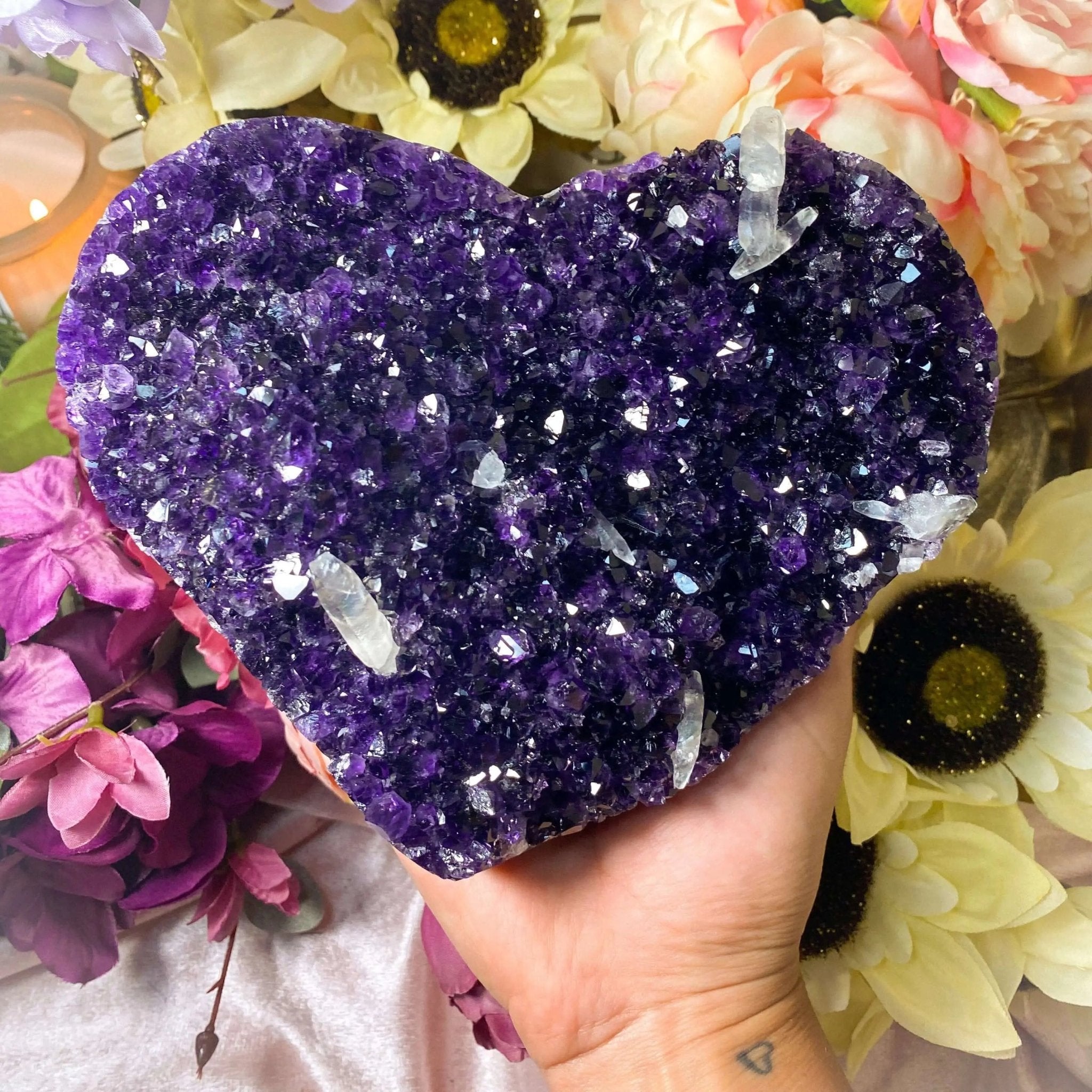The largest and most captivating Amethyst geodes are mined in South America, with Brazil and Uruguay producing a vast majority of the in-demand crystals. Many collectors and Amethyst admirers want to know--
What are the differences between Brazilian Amethyst and Uruguayan Amethyst, if any?
Having been mined for over 2,000 years--differences in Amethyst become noticeable. From physical appearance and quality to mining practices and healing properties here are the major (and not so major) differences between Brazilian and Uruguayan Amethyst.
Brazilian Amethyst
Iron mixes with silica under immense pressure for thousands and even millions of years to form, well, not such extraordinary rocks. But that’s only at first glance. Because once they’ve been cracked and opened they expose the breathtaking purple Amethyst crystal. These transparent prismatic crystals can be found in clusters as an incrustation in a nodular stone, referred to as a geode.
Large deposits were found in the Brazilian state of Minas Gerais in the 19th century and have brought joy, color, and healing to millions of people all over the world since. As the primary source of Amethyst, Brazilian Amethyst is the most common among wholesalers, and if you have a small or medium-sized Amethyst of your own, it was likely mined in Brazil.
Beyond its abundance, Brazilian Amethyst is slightly more durable, lighter in color, maintains a noticeably shorter and more shallow stature than its Uruguayan counterpart.
Uruguayan Amethyst
In the crystal world, size matters, and Uruguay is known for producing the bigger Amethyst Geode pieces. If you get the honor of being in the presence of a deep-purple geode standing taller than you, it most likely was sourced from Uruguay.
Uruguayan Amethyst looks as if a chunk of an Amethyst cave was removed and placed right into your meditation studio. It’s breathtaking and awe-inspiring. Raw and natural-looking but still maintaining a clean, polished finished makes it easy to spot Uruguayan amethyst.
Slightly rarer and in-demand than Brazilian Amethyst, mostly due to its color and size variations, Uruguayan Amethyst is often at a higher price point, but not always.
What’s the Difference?
In general, some of the best Amethyst caves are found in Brazil but the undeniable truth is Uruguay produces some of the deepest colored Amethyst. Colors that are so alluring, including deep purple or plum, to almost black Amethyst, are from Uruguay.
High-quality amethyst is found in both Brazil and Uruguay. But though Uruguayan Amethyst is less common than the vast production from Brazil, the quality tends, on average, to be higher. Where much of the Brazilian Amethyst is a pale violet or mid-toned purple, the Uruguayan Amethyst tends to be a highly saturated deep purple, sometimes with blue or red flashes. The richer color is very much in demand for finer jewelry, so the Uruguayan Amethyst may sell for a premium price. The Uruguayan Amethyst is such a saturated purple that some material has to be rejected as it’s too dark, a problem that hardly ever occurs with Brazilian Amethyst.
Amethyst geodes and clusters from Brazil are equally stunning, and the color quality is all over the spectrum but you can’t find the level of clarity in the Amethyst in Uruguay as you can in Brazil. These beautiful specimens are sometimes such a light purple yet see-through like glass. A true rarity not found in many other Amethyst caves.
Uruguayan Amethyst is a durable gem and falls at a 7 on the Mohs scale of durability with Brazilian Amethyst falling slightly lower than that. This makes them both suitable for jewelry and somewhat difficult to tatter and wear.
Brazil is a prolific producer of Amethyst while Uruguay remains a premier source. But beyond trade, these Amethyst hold different means and purposes for the everyday crystal user.
Brazilian Amethyst Meanings & Uses
Historically referred to as the “stone of sobriety”, Brazilian Amethyst is especially good for breaking unwanted habits and is used to detoxify the mind, body, and spirit. If you want to clear your aura, remove lingering pain and trauma, and revitalize your physical stamina and tolerance--Brazilian Amethyst is the way to go.
Uruguayan Amethyst Meanings & Uses
The size and depth of color found in Uruguayan Amethyst make its vibrational resonance differ from Brazilian Amethyst. Its frequency is said to be higher making it more suitable for spiritual enlightenment, improving intuition or psychic gifts, reiki healing practices, and warding off evil or psychic attacks.
Amethyst Similarities
You might have noticed, Brazilian Amethyst and Uruguayans Amethyst have more similarities than they do differently. Though the differences are few, they’re pretty significant. If you want to have both in your collection (which you def should!) here’s how you can care for them both.
Cleaning
Clean your Brazilian and Uruguayan Amethyst with gentle soap and lukewarm water, scrubbing behind the gem with a very soft toothbrush as necessary. After cleaning, pat dry with a soft towel or chamois cloth.
Uses
Amethyst is known to draw out unstable thoughts that create anxiety and stress. Simultaneously, Amethyst can encourage those on a spiritual journey toward self-improvement and enlightenment. It’s also said to be the most powerful crystal for healing physical ailments. Believed to be closely linked to divine source energy, the uses of Amethyst are tremendous and varied. Depending on its source, you can use Amethyst based on its “specialty” (mentioned above). But here are how you can use both your Amethyst from Brazil or Uruguay.
- Cleanse the energy of a space
- Manifest physical and emotional healing
- New beginnings
- Remove negative thinking patterns
- Balancing the Throat, Third Eye, and Crown Chakra
- Awe-inspiring decor/centerpiece
You can’t go wrong with Amethyst, whether it’s sourced from Brazil or Uruguay it is a primary crystal in any collection that brings peace and restores harmony in the physical and spiritual realms of its user.





